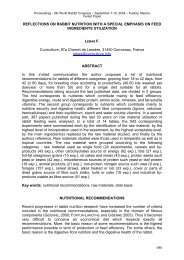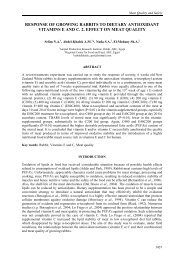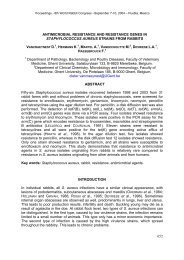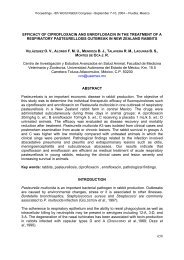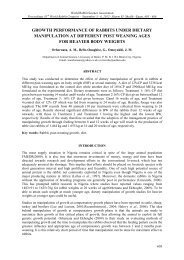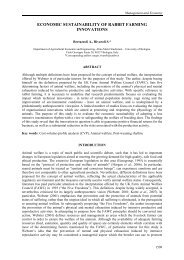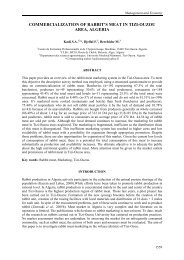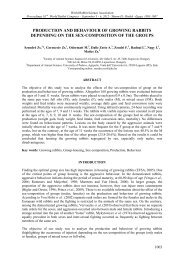effect of dietary supplementation with rapeseed and fish oil mixture ...
effect of dietary supplementation with rapeseed and fish oil mixture ...
effect of dietary supplementation with rapeseed and fish oil mixture ...
Create successful ePaper yourself
Turn your PDF publications into a flip-book with our unique Google optimized e-Paper software.
Meat Quality <strong>and</strong> SafetyEFFECT OF DIETARY SUPPLEMENTATION WITH RAPESEED ANDFISH OIL MIXTURE AND ANTIOXIDANT ON RABBIT MEATQUALITYKowalska D.National Research Institute <strong>of</strong> Animal Production, 32-083 Balice, ul. Krakowska 1, Pol<strong>and</strong>Corresponding author: dkowal@izoo.krakow.plABSTRACTThe aim <strong>of</strong> the study was to determine the <strong>effect</strong> <strong>of</strong> a <strong>rapeseed</strong> <strong>oil</strong> (2%) <strong>and</strong> <strong>fish</strong> <strong>oil</strong> (1%) <strong>mixture</strong> <strong>and</strong>antioxidant on rabbit meat quality. The natural antioxidant vitamin E was added to the diet to protectfat from oxidation.Thirty New Zeal<strong>and</strong> White female rabbits were investigated. Animals were assigned to three feedinggroups: group I – fed a pelleted basal diet <strong>with</strong> st<strong>and</strong>ard components; group II – fed a pelleted diet<strong>with</strong> 2% <strong>rapeseed</strong> <strong>oil</strong> <strong>and</strong> 1% <strong>fish</strong> <strong>oil</strong>; group III – fed a pelleted diet <strong>with</strong> 2% <strong>rapeseed</strong> <strong>oil</strong>, 1% <strong>fish</strong> <strong>oil</strong>,<strong>and</strong> 100% greater vitamin E content (increased from 50 to 100 mg/kg). Adding a <strong>mixture</strong> <strong>of</strong> <strong>rapeseed</strong><strong>oil</strong> (2%) <strong>and</strong> <strong>fish</strong> <strong>oil</strong> (1%) to rabbit feed had a favourable <strong>effect</strong> on the composition <strong>of</strong> the lipidfraction <strong>of</strong> meat. There was a decrease in total saturated fatty acids <strong>and</strong> a significant increase in n-3polyunsaturated fatty acids (especially EPA <strong>and</strong> DHA). The use <strong>of</strong> the natural antioxidant vitamin E inthe diet <strong>of</strong> group III caused a significant increase in EPA <strong>and</strong> total n-3 PUFA as well as having afavorable <strong>effect</strong> on reducing the susceptibility <strong>of</strong> muscle lipids to oxidation during the frozen storage<strong>of</strong> meat. The addition <strong>of</strong> a <strong>rapeseed</strong> <strong>and</strong> <strong>fish</strong> <strong>oil</strong> <strong>mixture</strong> to rabbit diets had no <strong>effect</strong> on the sensoryevaluation <strong>of</strong> the analyzed meat.Key words: Rabbits, Rapeseed <strong>oil</strong>, Fish <strong>oil</strong>, Fatty acids, Meat.INTRODUCTIONFunctional food, which in addition to traditional nutritional value has health-promoting <strong>effect</strong>s on thehuman body, has attracted the attention <strong>of</strong> researchers for many years. The main fatty acids found inmeat <strong>and</strong> fat products <strong>of</strong> animal origin (except <strong>fish</strong>) are saturated <strong>and</strong> polyunsaturated fatty acids <strong>of</strong> then-6 series. Polyunsaturated fatty acids (PUFA) such as C20:5 n-3 (EPA), C22:5n-3 (DPA) <strong>and</strong>C22:6n-3 (DHA), <strong>and</strong> conjugated linolenic acid (CLA) have health-promoting <strong>effect</strong>s on humans.Among the many isomers <strong>of</strong> linolenic acid, two CLA isomers (cis-9, trans-11; trans-10, cis-12) havespecial biological activity (Carta et al., 2002). They are known to inhibit the growth <strong>of</strong> cancerous cells,delay the development <strong>of</strong> atherosclerosis, reduce adipose tissue <strong>with</strong>out <strong>effect</strong>s on muscle weight,delay the development <strong>of</strong> type II diabetes, <strong>and</strong> show bacteriostatic activity.The fatty acid pr<strong>of</strong>ile <strong>of</strong> rabbit tissues depends on many factors such as breed, type <strong>of</strong> tissue, age <strong>and</strong>slaughter weight. Enriching complete diets <strong>with</strong> components high in n-3 PUFA makes it possible toprogramme the fatty acid pr<strong>of</strong>ile <strong>of</strong> meat as a result <strong>of</strong> transferring certain components from the feed.The aim <strong>of</strong> the present study was to determine the <strong>effect</strong> <strong>of</strong> a <strong>rapeseed</strong> <strong>oil</strong> (2%) <strong>and</strong> <strong>fish</strong> <strong>oil</strong> (1%)<strong>mixture</strong> <strong>and</strong> antioxidant on rabbit meat quality. Long-chain fatty acids from <strong>fish</strong> <strong>oil</strong> enrich tissue <strong>with</strong>n-3 PUFA in a physiologically most <strong>effect</strong>ive way, whereas <strong>rapeseed</strong> <strong>oil</strong> contains considerableamounts <strong>of</strong> α-linolenic acid, which is the precursor <strong>of</strong> long-chain n-3 PUFA <strong>and</strong> can be partlytransformed to EPA, DPA <strong>and</strong> DHA in the body. The natural antioxidant vitamin E was added to thediet to protect fat from oxidation.1371
9 th World Rabbit Congress – June 10-13, 2008 – Verona – ItalyMATERIALS AND METHODSThirty New Zeal<strong>and</strong> White female rabbits were investigated. Animals were assigned to three feedinggroups: group I – fed a pelleted basal diet <strong>with</strong> st<strong>and</strong>ard components, group II – fed a pelleted diet<strong>with</strong> 2% <strong>rapeseed</strong> <strong>oil</strong> <strong>and</strong> 1% <strong>fish</strong> <strong>oil</strong>, group III – fed a pelleted diet <strong>with</strong> 2% <strong>rapeseed</strong> <strong>oil</strong>, 1% <strong>fish</strong> <strong>oil</strong>,<strong>and</strong> 100% greater vitamin E content (increased from 50 to 100 mg/kg). The <strong>fish</strong> <strong>oil</strong> used was abyproduct <strong>of</strong> <strong>fish</strong> (herring, sprat <strong>and</strong> mackerel) processing <strong>and</strong> contained 8.4% EPA <strong>and</strong> 13.6% DHA.Rapeseed <strong>oil</strong> was made from <strong>rapeseed</strong> variety Spencer <strong>and</strong> contained 27.6% linoleic acid <strong>and</strong> 10.2%linolenic acid.The complete st<strong>and</strong>ard diet given to rabbits contained dried meadow grass, soybean meal, wheat bran,ground maize, milk replacer, NaCl, <strong>and</strong> a mineral <strong>and</strong> vitamin supplement The feeds were analysed fordry matter, crude ash, crude protein, crude fat, crude fibre <strong>and</strong> N-free extractives. The feed <strong>mixture</strong>s <strong>of</strong>all the groups were analyzed for the pr<strong>of</strong>ile <strong>of</strong> higher fatty acids using gas chromatography. Females<strong>of</strong> the foundation stock were subjected to rationed feeding <strong>and</strong> received daily rations ranging from 150g feed during the non-coupling period to 300 g during gestation <strong>and</strong> rearing <strong>of</strong> the young to 21 days.After this period, the rations were increased to meet the nutrient requirements <strong>of</strong> growing rabbits.After weaning, animals were moved to tiered cages, 4 animals per cage, <strong>and</strong> fed ad libitum. Females<strong>of</strong> the foundation stock were kept in cages on deep litter (straw), thanks to which the animals wereable to make up for possible <strong>dietary</strong> fibre deficiency.The experiment was terminated by the slaughter <strong>of</strong> animals at 3 months <strong>of</strong> age (6 animals per group).Carcasses were dissected <strong>and</strong> the samples <strong>of</strong> hind leg muscles were analysed for the pr<strong>of</strong>ile <strong>of</strong> fattyacids using gas chromatography, total cholesterol by the colourimetric method <strong>with</strong> 10% FeCl 3solution diluted 100-fold <strong>with</strong> sulphuric acid, vitamin E by the HPLC method using materials <strong>with</strong>solid consistency <strong>and</strong> malondialdehyde (TBARS) after 14 <strong>and</strong> 90 days <strong>of</strong> storage using the reaction <strong>of</strong>secondary oxidation products <strong>with</strong> thiobarbituric acid. The musculus longissimus dorsi was matured at4°C for 3 days. The samples were heated to mild b<strong>oil</strong>ing in water (0.6% NaCl solution) at one partmuscle to two parts water until the internal sample temperature reached 85°C. Heat-treated meat wascooled under cover to room temperature, sliced <strong>and</strong> evaluated. Sensory analysis included theevaluation <strong>of</strong> aroma intensity, aroma quality, tenderness, juiciness, taste intensity <strong>and</strong> taste quality on ascale <strong>of</strong> 1 to 5 points (10 evaluators). Overall sensory quality was also calculated.The results were analysed statistically by analysis <strong>of</strong> variance <strong>and</strong> Duncan’s test, using StatgraphicsPlus 4.0 s<strong>of</strong>tware.RESULTS AND DISCUSSIONTable 1 presents the results <strong>of</strong> basic analysis for complete pelleted diets. The addition <strong>of</strong> a <strong>rapeseed</strong> <strong>oil</strong><strong>and</strong> <strong>fish</strong> <strong>oil</strong> <strong>mixture</strong> increased the proportion <strong>of</strong> crude fat from 2.42% to 5.05%. In the methodology a3% increase in the level <strong>of</strong> <strong>dietary</strong> crude fat was assumed. In practice, the increase was approximately2.5%, which was probably due to the production process.Table 1: Nutrient content <strong>of</strong> the feeds (%)Group Dry matter Crude ash Crude protein Crude fat Crude fibre N-free extractivesI 89.4 5.83 16.7 2.42 12.2 58.1II 87.8 5.47 16.3 5.05 12.0 54.5III 88.7 5.30 16.3 5.04 11.9 55.4Table 2 presents the results <strong>of</strong> concentration <strong>of</strong> fatty acids in feed <strong>mixture</strong>s. There were highlysignificant differences in the final body weight <strong>of</strong> the rabbits (90 days <strong>of</strong> age) between the controlgroup <strong>and</strong> the experimental groups (group I – 2610 g, group II – 2790 g, group III – 2820 g). Nosignificant <strong>effect</strong> <strong>of</strong> added fat to the diet on carcass fatness was found. Fat deposition in the body isaffected by the degree <strong>of</strong> saturation <strong>of</strong> <strong>dietary</strong> fatty acids. Low-saturated fats can result in lower1372
Meat Quality <strong>and</strong> Safetyfatness (Crespo <strong>and</strong> Esteve-Garcia, 2002). The <strong>dietary</strong> factor used in the experiment had a significant<strong>effect</strong> (P≤0.05) on the muscularity <strong>of</strong> animals from the experimental groups.Table 2: The concentration <strong>of</strong> fatty AIDS (% <strong>of</strong> Total AIDS) In feed <strong>mixture</strong>sItem Group - I Group - II Group – IIIC8:0 0.00 0.00 0.00C10:0 0.00 0.00 0.00C12:0 0.00 0.00 0.00C14:0 0.17 0.53 0.76C16:0 16.27 11.55 12.19C16:1 0.22 0.76 0.98C18:0 2.13 2.01 1.92C18:1 20.27 30.51 33.79C18:2n-6 52.83 36.51 37.23C18:3n-3 6.74 15.14 14.94C20:0 0.57 0.44 0.58CLAc9t11 0.06 0.07 0.12CLAt10c12 0.05 0.08 0.09CLAc9c11 0.00 0.00 0.00CLAt9t11 0.09 0.02 0.04C20:4n-6 0.00 0.00 0.00C22:1 0.10 0.32 0.39C20:5n-3(EPA) 0.00 0.67 0.91C22:6n-3(DHA) 0.00 1.06 1.51SFA 19.63 14.84 15.89PUFA 59.77 53.57 54.60PUFAn-6 52.83 36.52 37.24PUFAn-3 6.74 16.87 17.36PUFA/SFA 3.04 3.61 3.44PUFAn-6/n-3 7.83 2.16 2.15The addition <strong>of</strong> <strong>oil</strong> to the diet had no <strong>effect</strong> on carcass fatness. The analysis <strong>of</strong> the fatty acidcomposition <strong>of</strong> hind leg muscle lipids showed that the addition <strong>of</strong> <strong>rapeseed</strong> <strong>oil</strong> <strong>and</strong> <strong>fish</strong> <strong>oil</strong> to thepelleted diet had a favourable <strong>effect</strong> on the dietetic value <strong>of</strong> rabbit meat (Table 3).The total level <strong>of</strong> saturated fatty acids was found to decrease. In the experimental groups, there werehighly significant increases in the level <strong>of</strong> n-3 PUFA, especially EPA <strong>and</strong> DHA, according to theconsiderable proportion <strong>of</strong> these acids in <strong>fish</strong> <strong>oil</strong>. Koreleski et al. (1998) reported that the addition <strong>of</strong><strong>rapeseed</strong> <strong>oil</strong> to the feed is paralleled by an increase in n-3 PUFA due to the synthesis <strong>of</strong> n-3 LC PUFAfrom the LNA precursor under the influence <strong>of</strong> the enzymatic action <strong>of</strong> desaturases <strong>and</strong> elongases. Inthe meat <strong>of</strong> the experimental groups, there was a highly significant increase in the isomer <strong>of</strong> linolenicacid CLAt10c12, which is known to inhibit the development <strong>of</strong> cancerous cells. The n-6 to n-3 PUFAratio was favourable. The use <strong>of</strong> the natural antioxidant vitamin E in the feed <strong>of</strong> group III significantlyincreased EPA <strong>and</strong> total n-3 PUFA.The cholesterol content <strong>of</strong> the body is determined by genetic <strong>and</strong> environmental factors, <strong>with</strong> nutritionplaying an important role among the latter. Cholesterol quantity is affected not so much by thepresence <strong>of</strong> saturated fatty acids in the diet as the relationships between these acids. The n-6 to n-3PUFA ratio in the feed has an <strong>effect</strong> on the fatty acid composition <strong>of</strong> cell membrane phospholipids,which determines the permeability <strong>of</strong> these membranes. Studies have shown a positive correlationbetween cholesterol content <strong>and</strong> the degree <strong>of</strong> carcass fatness (Jelińska, 2005). In group III, there wasa highly significant (P≤0.05) reduction in the amount <strong>of</strong> cholesterol in the analysed meat.Considerable vitamin E deposition in the meat was observed after it was added to the diet. This is <strong>of</strong>great importance to the consumers because to ensure appropriate absorption <strong>of</strong> PUFA, they should beingested together <strong>with</strong> vitamin E as a natural antioxidant; the recommended amount is 0.4 mg <strong>of</strong> α-tocopherol per g <strong>of</strong> acids (Gibney et al., 2002).1373
9 th World Rabbit Congress – June 10-13, 2008 – Verona – ItalyTable 3: Level <strong>of</strong> fatty acids (% total acids), total cholesterol (mg/100 g) <strong>and</strong> TBA (mg/kg) in themuscle tissue <strong>of</strong> hind legItem Group - I Group - II Group – III seC8:0 0.03 0.01 0.02 0.02C10:0 0.53A 0.10B 0.14B 0.18C12:0 0.34 0.10 0.14 0.10C14:0 2.41a 2.51a 3.28b 0.16C16:0 21.8a 17.6ab 19.9b 1.17C16:1 3.25 3.27 4.22 0.45C18:0 5.45 4.44 4.48 0.19C18:1 21.8A 17.1B 17.9B 0.61C18:2n-6 38.5 38.7 35.1 1.41C18:3n-3 2.12A 5.47B 3.95B 0.93C20:0 0.09A 0.06B 0.05B 0.01CLAc9t11 0.05 0.06 0.06 0.01CLAt10c12 0.01A 0.09B 0.08B 0.01CLAc9c11 0.01 0.01 0.01 0.01CLAt9t11 0.51A 1.29B 1.32B 0.12C20:4n-6 1.77A 0.95B 0.88B 0.12C22:1 0.03 0.02 0.06 0.04C20:5n-3(EPA) 0.13A 1.52B 1.70B 0.01C22:6n-3(DHA) 0.93A 6.32B 6,38B 0.17SFA 30.7a 24.9b 28.0b 1.48PUFA 44.2A 54.6B 49.7B 1.90PUFAn-6 40.4 39.8 36,1 1.38PUFAn-3 3.20A 13.3B 12.0B 0.91PUFA/SFA 1.44A 2.20B 1.78A 0.18PUFAn-6/n-3 13.4A 3.01B 3.05B 1.12Cholesterol 66.3a 60.5 57.5b 3.61Vitamin E 1.81A 2.19A 3,56B 0.47TBA-RS14 0.34A 0.33A 0.17B 0.25TBA-RS90 0.51A 0.52A 0.20B 0.14a,b: means <strong>with</strong> different letters differ significantly at P≤0.05, A,B: at P≤0.01The addition <strong>of</strong> vitamin E to the diet at a rate <strong>of</strong> 100 mg/kg had a beneficial <strong>effect</strong> on reducing thesusceptibility <strong>of</strong> muscle lipids to oxidation processes during the frozen storage <strong>of</strong> meat. Similarfindings were reported by Connor (2000) <strong>and</strong> Ramirez et al. (2005), who showed a positive <strong>effect</strong> <strong>of</strong>adding fat to rabbit diets on the level <strong>of</strong> desirable fatty acids <strong>and</strong> on reducing cholesterol in rabbitmeat.Cooking was applied as the meat preparation method for sensory analysis <strong>of</strong> the musculus longissimusdorsi (Table 4). This resulted from the fact that the analysis should give special attention to the aroma<strong>of</strong> the samples. This heat treatment method is the most <strong>effect</strong>ive in eliciting the intensity <strong>and</strong> typicalaroma <strong>of</strong> rabbit meat, <strong>and</strong> is not objected to by panelists on the grounds <strong>of</strong> the samples beingundercooked. No statistical differences were found between the groups in the overall sensory quality,which shows that the addition <strong>of</strong> <strong>rapeseed</strong> <strong>and</strong> <strong>fish</strong> <strong>oil</strong>s had no negative <strong>effect</strong> on the sensory traits <strong>of</strong>meat.Table 4: Sensory traits <strong>of</strong> meat (mean scores)Trait Group I Group II Group III seAroma intensity 4.8 4.8 4.8 0.01Aroma quality 4.2 4.0 4.0 0.05Tenderness 4.4 4.8 4.8 0.22Juiciness 4.4 4.6 4.6 0.07Taste intensity 4.0 4.0 4.0 0.01Taste quality 4.6 4.6 4.6 0.01Overall sensory quality 4.40 4.45 4.46 0.06CONCLUSIONSIn summary, the addition <strong>of</strong> <strong>rapeseed</strong> <strong>oil</strong> (2%) <strong>and</strong> <strong>fish</strong> <strong>oil</strong> (1%) to rabbit diets had a favourable <strong>effect</strong>on the composition <strong>of</strong> the meat lipid fraction. There was a decrease in the total level <strong>of</strong> saturated fatty1374
Meat Quality <strong>and</strong> Safetyacids <strong>and</strong> a highly significant increase in the level <strong>of</strong> n-3 PUFA (especially EPA <strong>and</strong> DHA) <strong>and</strong>linolenic acid isomers. The use <strong>of</strong> the natural antioxidant vitamin E in the diet <strong>of</strong> group III caused asignificant increase in EPA <strong>and</strong> total n-3 PUFA, as well as having a beneficial <strong>effect</strong> on reducing thesusceptibility <strong>of</strong> muscle lipids to oxidation during the frozen storage <strong>of</strong> meat. The addition <strong>of</strong> a<strong>rapeseed</strong> <strong>and</strong> <strong>fish</strong> <strong>oil</strong> <strong>mixture</strong> to rabbit diets had no <strong>effect</strong> on the sensory traits <strong>of</strong> the analysed meat.ACKNOWLEDGEMENTSThis study was financed from the 2006-2009 budget for science as research project no. 2PO62 03 230.REFERENCESCarta G., Angioni E., Murru E., Melis M.P., Spada S., Banni S. 2002. Modulation <strong>of</strong> lipid metabolism <strong>and</strong> vitamin A byconjugated linoleic acid prostagladins, leukotrienes <strong>and</strong> essentials fatty acids. J. Lipid Res., 67, 187-191.Crespo N., Esteve-Garcia E. 2002. Nutrient <strong>and</strong> fatty acid deposition in br<strong>oil</strong>ers fed different <strong>dietary</strong> fatty acid pr<strong>of</strong>iles.Poultry Sci., 81, 1533-1542.Connor W.E. 2000. Importance <strong>of</strong> n-3 fatty acids in health <strong>and</strong> disease. Am. J. Clin. Nutr., 71 (suppl), 171S-5S.Gibney M.J., Vorster H.H., Kok F.J. 2002. Introduction to Human Nutrition. Blackwell Science, Oxford, UK.Jelińska M. 2005. Fatty acids – carcinogenesis modifying factors. Biul. Wydz. Farm. AMW, 1.Koreleski J., Kuchta M., Rys R., Sieradzka A. 1998. Comparison <strong>of</strong> the influence <strong>of</strong> <strong>rapeseed</strong> <strong>oil</strong> <strong>and</strong> <strong>fish</strong> fat in laying hennutrition on the level <strong>of</strong> polyunsaturated fatty acids in egg yolk. Rocz. Nauk. Zoot., 25, 91-102.Ramirez J., Diaz I., Pla M., Gil M., Blasco A., Oliver M.A. 2005. Fatty acid composition <strong>of</strong> leg meat <strong>and</strong> perirenal fat <strong>of</strong>rabbits selected by growth rate. Food Chem., 90, 251-256.1375
9 th World Rabbit Congress – June 10-13, 2008 – Verona – Italy1376





